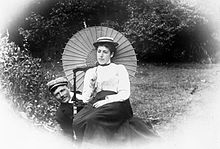Frances Hodgkins
[3] In 1901, Hodgkins left New Zealand for Europe, enrolling in art school in London but also travelling and painting in France, the Netherlands, Italy and Morocco in the company of friend and fellow artist Dorothy Kate Richmond; whom she described as "the dearest woman with the most beautiful face and expression.
During this time she exhibited numerous watercolours at the Paris salon and came in contact with Canadian artist, Emily Carr, whom she taught while working on seascapes at Concarneau in Brittany.
During World War I she spent some time in Zennor, Cornwall, where she worked with the Swansea painter, Cedric Morris, who painted her portrait in 1917.
In 1919, after the War, she went to France, where she was influenced by Matisse and Derain, but developed her own highly personal style, which made a strong impact at her one-person show in London at the Claridge Gallery in 1928.
[9] In 1925, Hodgkins started work as a fabric designer at the Calico Printers' Association (CPA) in Manchester and during her employment visited the Exposition Internationale des Arts Decoratifs in Paris.
[11] In 1929 she joined the Seven and Five Society and worked alongside younger artists including Barbara Hepworth, Ben Nicholson and Henry Moore.
[13] Her experimentation with mixing artistic genres continued, resulting in paintings that conflate still life with self-portraiture to sidestep physical appearance in self-representation.
[14] After her death her close friend and fellow artist Amy Krauss, boxed up the possessions from her studio and arranged for her ashes to be returned to New Zealand.
The Christchurch City Council finally accepted the watercolour Pleasure Garden into the collection of the Robert McDougall Art Gallery in 1951.
